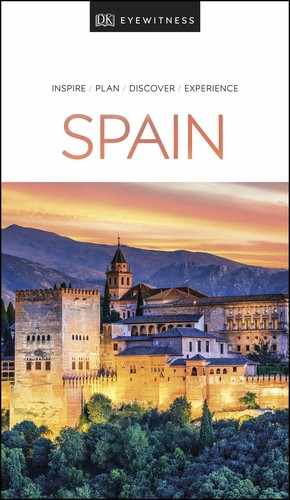Experience More
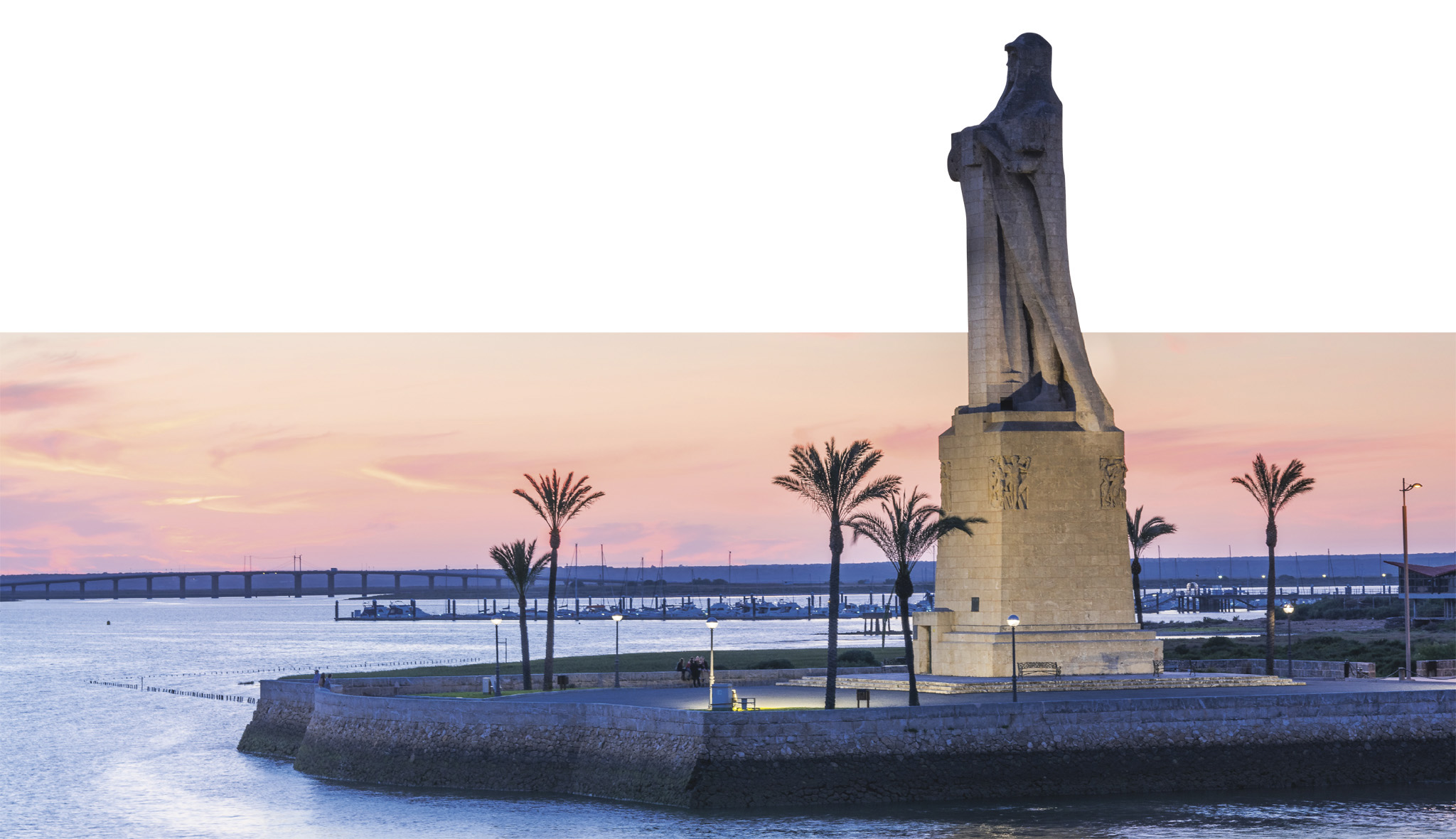
t The Monumento a la Fe Descubridora in Huelva
Founded as Onuba by the Phoenicians, Huelva had its grandest days as a Roman port. It was almost wiped out in the great Lisbon earthquake of 1755. It is an industrial city today, sprawling around the quayside on the Río Odiel.
Columbus’s departure for the New World from Palos de la Frontera, across the Río Odiel estuary, is celebrated in the excellent Museo Provincial, which also charts the history of the Rio Tinto mines. To the east of the centre, the Barrio Reina Victoria is a bizarre example of English mock-Tudor suburban bungalows built by the Rio Tinto Company for its workers in the early 20th century. South of the town, at Punta del Sebo, the Monumento a la Fe Descubridora, a rather bleak statue of a navigator looking towards the New World, created by Gertrude Vanderbilt Whitney in 1929, dominates the Odiel estuary.
There are three resorts with sandy beaches near Huelva: Punta Umbria, next to the bird-rich wetlands of the Marismas del Odiel; Isla Cristina, an important fishing port; and Mazagón, with windswept dunes.
Museo Provincial
⌂ Alameda Sundheim 13 § 959 65 04 24 # 9am–8pm Tue–Sat, 9am–3pm Sun
This wild mountain range is one of the most remote and least visited corners of Andalucía. Dominated by the ruins of a Moorish fort, the hillside above Aracena is pitted with caverns and in one, the Gruta de las Maravillas, is a lake hung with many stalactites.
The village of Jabugo is famed for its ham, jamón ibérico or pata negra.
Off the A461 are the giant opencast mines at Minas de Riotinto, where iron, copper and silver have been exploited since Phoenician times. The Museo Minero traces the history of the Rio Tinto Company.
" '
Gruta de las Maravillas
⌂ Pozo de la Nieve § 663 93 78 76 # 10am–1:30pm & 3–6pm daily
" '
Museo Minero
⌂ Plaza del Museo # 10:30am–3pm & 4–7pm daily ¢ 1 & 6 Jan, 25 Dec ∑ parquemineroderiotinto.es
The Franciscan Monasterio de la Rábida was founded in the 15th century.
In 1491, a dejected Columbus sought refuge here after his plans to sail west to find the East Indies had been rejected by the Catholic Monarchs. Its prior, Juan Pérez, fatefully used his considerable influence as Queen Isabella’s confessor to reverse the royal decision.
Inside the monastery there are fine frescoes painted by Daniel Vásquez Díaz in 1930, which glorify the explorer’s life and discoveries. Also worth seeing are the Mudéjar cloisters, the gardens and the beamed chapterhouse.
EXPERIENCE Andalucía

Andalucían Fiestas
Carnival
Residents of Cádiz dress in elaborate costumes for one of Europe’s largest and most colourful Carnivals in February or March.
Día de la Cruz
In the first week in May, groups compete to create the most colourful crosses adorned with flowers on Granada and Córdoba’s squares and street corners.
Córdoba Patio Fiesta
Flower-decked patios in old Córdoba are opened to the public for displays of flamenco in mid-May.
Columbus Festival
This celebration of Columbus’s voyage, held in Huelva in late July or early August, is dedicated to the native music and dance of a different Latin American country every year.
Exaltación al Río Guadalquivir
In mid-August, horses are raced on the beach at the mouth of the Río Guadalquivir.
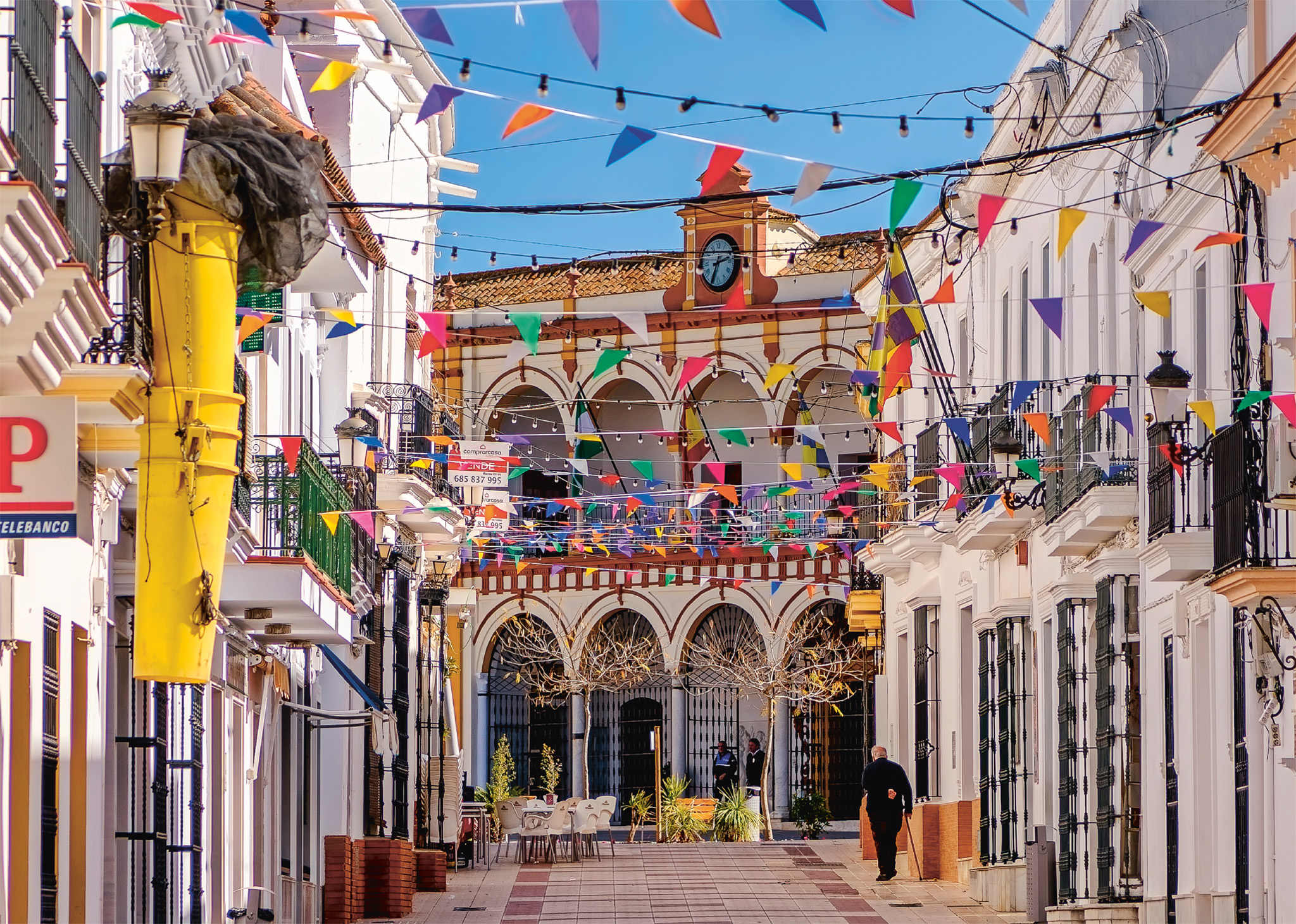
t Colourful flags decorating the streets of Moguer’s lovely Old Town
Columbus set sail for the New World on 3 August 1492 from Palos, the home town of his captains, brothers Martín and Vicente Pinzón. Martín’s former home, the Casa Museo de Martín Alonso Pinzón, is now a museum of exploration, and his statue is in the main square.
The 15th-century Iglesia de San Jorge has a fine portal, through which Columbus left after hearing Mass before boarding the Santa María.
Nearby, in the white town of Moguer, treasures include the 16th-century hermitage of Nuestra Señora de Montemayor, and the Neo-Classical town hall. The Monasterio de Santa Clara houses the Museo Diocesano de Arte Sacro.
"
Casa Museo de Martín Alonso Pinzón
⌂ Calle Colón 24 § 959 10 00 41 # 10am–2pm Mon–Fri
' "
Monasterio de Santa Clara
⌂ Plaza de las Monjas, Moguer § 959 37 01 07 # By guided tour only; Tue–Sun
EXPERIENCE Andalucía
|
Eat Azabache Expect innovative versions of local dishes at this Huelva eatery. The seafood is fresh and there's an extensive wine list. ⌂ Calle Vázquez Lopez 22, Huelva ∑ restauranteazabache.com ¡¡¡ El Bodegón Try the juicy solomillo a la brasa (oak-grilled sirloin steak) at this restaurant in Palos de la Frontera. ⌂ Calle Rábida 46, Palos de la Frontera § 959 53 11 05 ¡¡¡ Aires de Doñana (La Choza del Rocío) This choza (thatched hut) in Almonte is known for its revuelto marismeño (scrambled eggs with herbs). ⌂ Avenida de la Canaliega 1, Almonte § 959 44 22 89 ¡¡¡ |
EXPERIENCE Andalucía
|
Drink Bodegas Barbadillo Take a tour of this winery to discover how manzanilla sherry has been made here since 1821, before tasting some of this light, dry drink. You can even buy some bottles in the shop. ⌂ Calle de Luis de Eguilaz 11, Sanlúcar de Barrameda ∑ barbadillo.com The Harbour Bar & Restaurant As the name suggests, this bar has beautiful views of the boats in Marbella’s harbour. Come here for a creative cocktail or a glass of refreshing wine on a scorching day. ⌂ 1st Floor, Club Maritimo, Puerto Deportivo, Marbella ∑ theharbourmarbella.com |

t Parading the Virgin to the
Bordering the Parque Nacional de Doñana, El Rocío is famous for its annual romería, when almost a million people converge on the village. Many of the pilgrims travel from distant parts of Spain, some on gaudily decorated oxcarts, to visit the Iglesia de Nuestra Señora del Rocío, where a statue of the Virgin is said to have performed miraculous healings since 1280. Early on the Monday morning of the festival, men from Almonte fight to carry the statue in procession, and the crowd clambers onto the float to touch the image.

t Iglesia de Nuestra Señora del Rocío
A delightful fishing port standing at the mouth of the Río Guadalquivir, Sanlúcar is overlooked by a Moorish castle. This was the departure point for Columbus’s third voyage in 1498 and also for Magellan’s 1519 expedition to circumnavigate the globe.
As well as its connection to the conquistadors, Sanlúcar is also known for its light, dry manzanilla sherry made by historic producers, including Bodegas Barbadillo.
The town is a great base for exploring the Parque Nacional de Doñana. Setting sail from the quay, boats take visitors across the river to this wildlife haven.
Chipiona, located a short way along the coast, is a lively little resort town with an excellent beach. The walled town of Lebrija, inland, enjoys views over vineyards. Its Iglesia de Santa María de la Oliva is a reconsecrated 12th-century Almohad mosque.
Jerez is the capital of sherry production and many bodegas can be visited. The city is also famous for its Real Escuela Andaluza de Arte Ecuestre, an equestrian school with public displays on Thursdays all year (also Tuesdays March to December and some Fridays in summer). On other days you might be able to see the horses being trained. The Palacio del Tiempo, nearby, has one of the largest clock collections in Europe. On the Plaza de San Juan, the 18th-century Palacio de Penmartín houses the Centro Andaluz de Flamenco, where exhibitions give a good introduction to this music and dance tradition. The partially restored, 11th-century Alcázar encompasses a well-preserved mosque, now a church. Just to the north is the cathedral.
Near Jerez, the Monasterio de la Cartuja Santa María de la Defensión is considered one of the most beautiful in Spain.
To the southwest, the port of El Puerto de Santa María has some bodegas and a 13th-century castle.
"
Real Escuela Andaluza de Arte Ecuestre
⌂ Duque de Abrantes # Hours vary, check website ∑ realescuela.org
"
Palacio del Tiempo
⌂ Calle Cervantes 3 § 956 18 21 00 # 9:30am–2pm Tue–Sun
Palacio de Penmartín
⌂ Plaza de San Juan 1 § 956 90 21 34 # 11am–1:30pm & 5–8pm Mon–Fri ¢ Public hols
" '
Alcázar
⌂ Alameda Vieja § 956 14 99 55 # 9:30am–2:30pm daily ¢ 1 & 6 Jan, 25 Dec

t Deserted sandy beach, surrounded by dunes, at Bolonia on the Costa de la Luz
The Costa de la Luz (Coast of Light), which is between Cádiz and Tarifa at Spain’s southernmost tip, is an unspoiled, windswept stretch of coast characterized by strong, pure light – the source of its name. From the Sierra del Cabrito, to the west of Algeciras, it is often possible to see the outline of Tangier and the parched Moroccan landscape below the purple-tinged Rif mountains across the narrow Strait of Gibraltar.
Tarifa is named after an 8th-century Moorish commander, Tarif ben Maluk, who landed there with his forces during the Moorish conquest. Later, Tarifa and its 10th-century castle were defended by the legendary hero Guzmán during a siege by the Moors in 1292.
Tarifa has since become the windsurfing capital of Europe. The breezes that blow onto this coast also drive the many wind turbines on the hills.
Off the N340 (E5), at the end of a long, narrow road which strikes out across a wilderness of cacti, sunflowers and lone cork trees, is Zahara de los Atunes, a modest holiday resort with a few hotels. Conil de la Frontera, a little to the west, is busier and more built up.
Close by, off Cabo de Trafalgar, the English admiral Nelson defeated a Spanish and French fleet in the 1805 Battle of Trafalgar, but died during the battle.
EXPERIENCE Andalucía

Jerez Sherry Bodegas
Bodegas Álvaro Domecq
Located in the heart of Jerez de la Frontera, this bodega is all stone walls and barrels (www.alvarodomecq.com).
Bodegas La Cigarrera
This bodega dates back to 1758 (www.bodegaslacigarrera.com).
Bodegas González Byass – Tio Pepe
A complex of patios and gardens in Jerez (www.bodegastiopepe.com).
Bodegas Osborne
The Osborne bull is seen as the unofficial symbol of Spain (www.osborne.es).
Bodegas Sandeman
A well-known brand founded in 1790 (www.sandeman.eu).
Gibraltar Controversy
Britain seized Gibraltar during the War of the Spanish Succession in 1704, and was granted it “in perpetuity” nine years later. As the gateway to the Mediterranean, “the Rock” was essential to Britain in colonial times, and centuries later, in a 1967 referendum, residents voted overwhelmingly to stay under British rule. Tensions over Gibraltar had eased for a while, but the spectre of Britain’s exit from the European Union has caused renewed hostility.
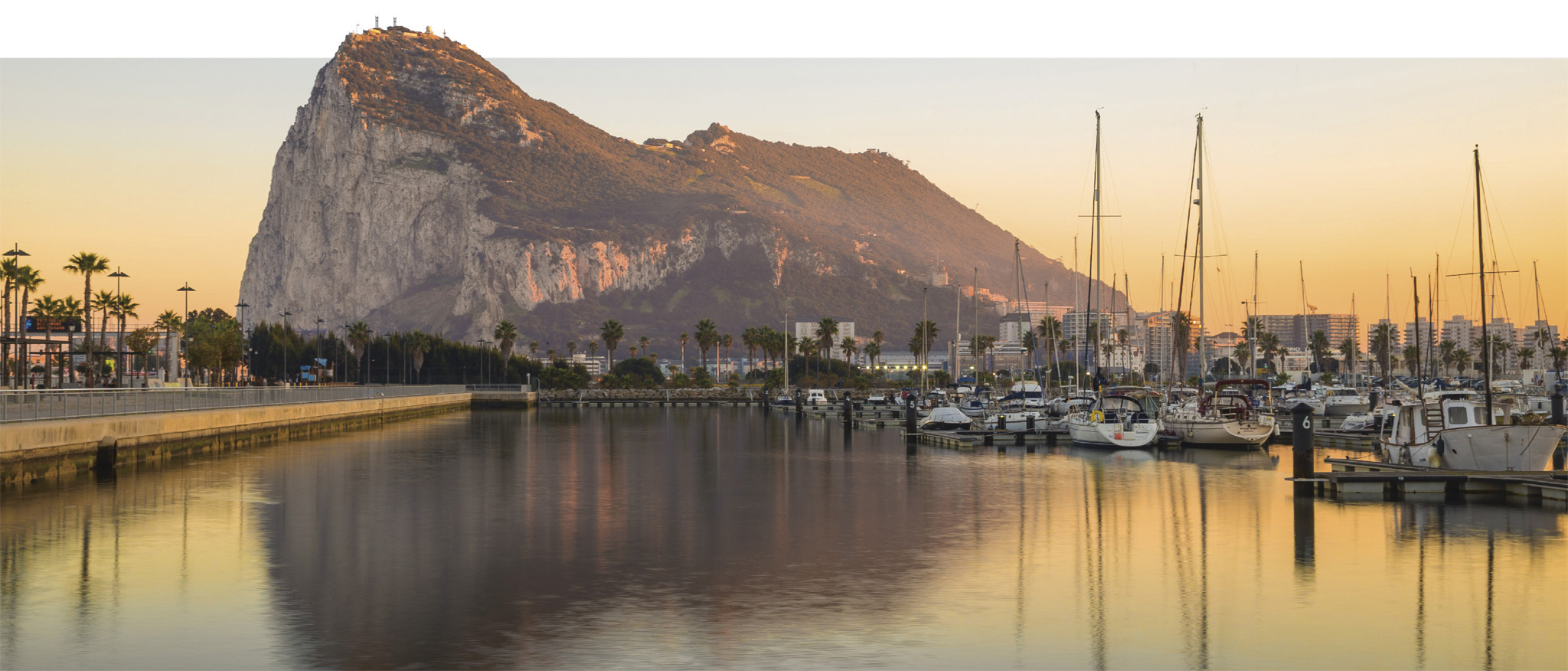
t The Rock of Gibraltar, towering over yachts in the harbour
The high, rocky headland of Gibraltar was signed over to Britain “in perpetuity” in the Treaty of Utrecht, which ended the War of Spanish Succession in 1713. Today, about 4 million people stream across the border annually from La Línea de la Concepción in Spain.
Among the most notable sights of Gibraltar are those testifying to its strategic military importance over the centuries. Halfway up the famous Rock are an 8th-century Moorish castle, whose keep was used as a prison until 2010, and 80 km (50 miles) of siege tunnels housing storerooms and barracks. St Michael’s Cave, which served as a hospital during World War II, is now used for classical concerts.
The Apes’ Den, near Europa Point, which is Gibraltar’s southernmost tip, is home to the tailless apes. Legend says that the British will keep the Rock only as long as the apes remain there.
A cable car takes visitors to the Top of the Rock, at 450 m (1,475 ft). Gibraltar Museum charts the colony’s history.
"
The Keep, Siege Tunnels, St Michael’s Cave, Apes’ Den
⌂ Upper Rock Area § (+35) 020 04 59 57 # 9:30am–6:15pm daily
"
Gibraltar Museum
⌂ 18 Bombhouse Lane # 10am–6pm Mon–Fri, 10am–2pm Sat ¢ Public hols ∑ gibmuseum.gi
From the industrial city of Algeciras, there are spectacular views of Gibraltar. The city is a major fishing port and Europe’s main gateway for ferries to North Africa, especially Tangier and Spain’s territories of Ceuta and Melilla.
One of Europe’s most exclusive resorts, Marbella is frequented by royalty and film stars. There are 24 beaches, including Playa Rio Verde and Playa Nagueles.
Among the delights of the Old Town, with its spotlessly clean alleys, squares, and smart shops and restaurants, is the Iglesia de Nuestra Señora de la Encarnación. The Museo del Grabado Español Contemporáneo displays some of Pablo Picasso’s least-known work.
West along the coast, Puerto Banús is Marbella’s ostentatious marina. The expensive shops, restaurants and glittering nightlife reflect the wealth of its clientele.
In complete contrast to Marbella, 31 km (19 miles) southwest, the quiet resort town of Estepona is popular with families with young children. This is most evident early evening, when families gather on the palm-lined promenade. Back behind the coastal road, old squares are shaded by orange trees and retain a charming Spanish atmosphere. At one end of town is a stylish marina with waterside restaurants, beyond which villa complexes stretch out along the coast.
Many golf courses dot the landscape between Marbella and Estepona and are popular all year round.
"
Museo del Grabado Español Contemporáneo
⌂ Calle Hospital Bazan # 9am–2pm Mon & Sat, 9am–7pm Tue–Fri ∑ mgec.es
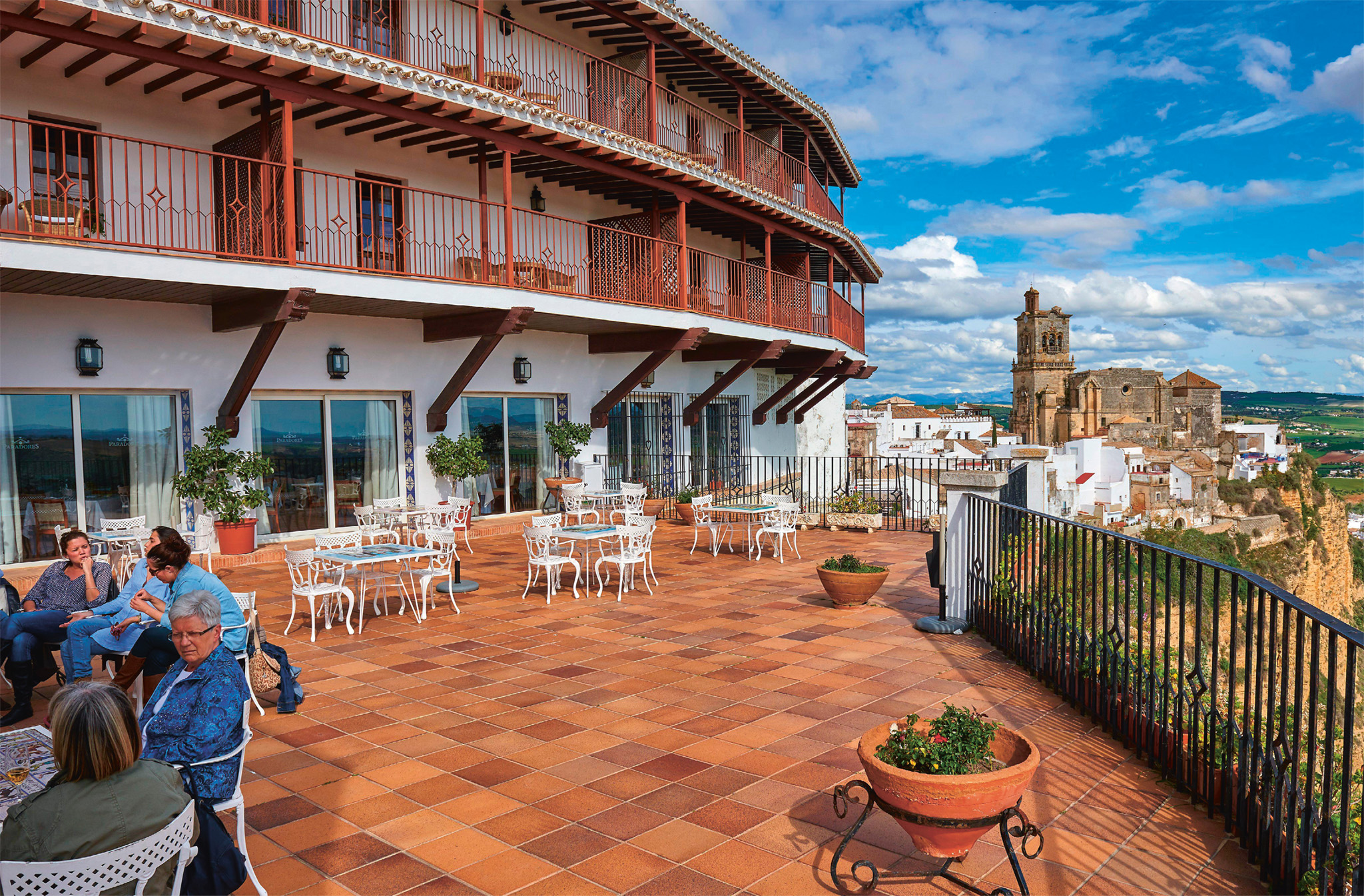
t Customers enjoying the view over Arcos de la Frontera from a hotel terrace
Although legend has it that a son of Noah founded Arcos, it was in fact the Iberians. It gained the name Arcobriga in the Roman era and, under the Caliphate of Córdoba, became the Moorish stronghold of Medina Arkosh. It is an archetypal white town, with a labyrinthine old quarter.
On the Plaza de España are the parador and the Iglesia de Santa María de la Asunción, a late Gothic-Mudéjar building noted for its choir stalls and altarpiece. The huge, Gothic Iglesia de San Pedro, perched on the edge of a cliff formed by the Río Guadalete, is a striking building. Nearby is the Palacio del Mayorazgo, which has a highly elaborate Renaissance façade. The ayuntamiento features a fine Mudéjar ceiling.
In the 15th century the Guzmán family was granted the dukedom of Medina Sidonia, a white town west of Arcos de la Frontera. The area became one of the most important ducal seats in Spain. The Gothic Iglesia de Santa María la Coronada is the town’s finest building. It contains a notable collection of Renaissance religious art.
Palacio del Mayorazgo
⌂ Calle Nuñez del Prado § 956 70 30 13 (Casa de Cultura) # 10am–2pm Mon–Fri
Ayuntamiento
⌂ Plaza del Cabildo § 956 70 49 50 # Mon–Fri, call to check
EXPERIENCE Andalucía
|
Stay Hotel Fuerte Marbella’s very first purpose-built luxury hotel features lush gardens and two outdoor pools, as well as a fitness centre with an indoor pool. It’s located close to the beach. ⌂ Calle El Fuerte, Marbella ∑ fuertehoteles.com ¡¡¡ Casa Grande A whitewashed 18th-century mansion on a hill in Arcos de la Frontera, offering great views of the countryside below. Each room is decorated differently, but they are all furnished with gorgeous antiques . ⌂ Calle Maldonaldo 10, Arcos de la Frontera ∑ lacasagrande.net ¡¡¡ |

t People taking in the weathered limestone formations of El Torcal
A massive hump of limestone, which has been weathered into bizarre rock formations and caves, the Parque Natural del Torcal is popular with hikers. Marked trails lead from a visitors’ centre. The park has fox and weasel populations, colonies of eagles, hawks and vultures, and rare plants and flowers like wild orchids.
Parque Natural del Torcal
§ 952 24 33 24 # 10am–5pm daily (to 7pm Apr–Sep)
Up the fertile Guadalhorce Valley, beyond the village of El Chorro, is a geographical wonder. The Garganta del Chorro is an immense chasm, 180 m (590 ft) deep and in places only 10 m (30 ft) wide, cut by the river through a limestone mountain.
Álora, a classic Andalucían white town with a ruined Moorish castle and an 18th-century church, lies 12 km (7 miles) down the valley.
Along the twisting MA441 from Álora is the village of Carratraca. In the 19th and early 20th centuries, Europe’s highest society travelled here for the healing powers of the sulphurous springs. These days, Carratraca has a faded glory – water still gushes out at 700 litres (155 UK and 185 US gal) a minute and the outdoor baths remain open, but they are little used.

Hidden Gem
Walk This Way
Take a walk on the Caminito del Rey, a 100-m- (328-ft-) high walkway, clinging to the rock face, which leads to a bridge across the Garganta del Chorro (www.caminitodelrey.info). It’s not for sufferers of vertigo!
This busy market town was strategically important first as Roman Anticaria and later as a Moorish border fortress defending Granada.
Of its many churches, the Iglesia de Nuestra Señora del Carmen, with its vast Baroque altarpiece, is not to be missed.
The hilltop castle was built in the 13th century on the site of a Roman fort. Visitors can walk round the castle walls by approaching through the 16th-century Arco de los Gigantes.There are excellent views of Antequera from the Torre del Papabellotas on the best-preserved part of the wall.
In the town below, the 18th- century Palacio de Nájera is the setting for the Municipal Museum - the star exhibit is a Roman bronze statue of a boy.
The massive dolmens, just outside the town, are thought to be the burial chambers of tribal leaders and date from around 2500–2000 BC.
Laguna de la Fuente de Piedra, north of Antequera, teems with bird life, including huge flocks of flamingos, which arrive to breed after wintering in West Africa.
"
Palacio de Nájera
⌂ Coso Viejo § 952 70 83 00 # 10am–2pm & 4:30–6:30pm Tue–Sat, 9:30am–2pm Sun
The second-largest city in Andalucía, Málaga, is a thriving port, as it has been since Phoenician times. It also flourished during the 19th century, when sweet Málaga wine was one of Europe’s most popular drinks – until phylloxera ravaged its vineyards in 1876.
The cathedral, begun in 1528 by Diego de Siloé, is a bizarre mix of styles. The half-built second tower gave the cathedral its nickname: La Manquita (“the one-armed one”).
The Museo Picasso Málaga displays works by the native artist, while the Casa Natal de Picasso, where the painter spent his early years, is now the Picasso Foundation. The Centre Pompidou Málaga has a good collection of modern and contemporary artworks.
Málaga’s vast Alcazaba was built between the 8th and 11th centuries. There is a partially excavated Roman amphitheatre by its entrance. Housed in the Palacio de la Aduana, the Museo de Málaga displays archaeological artifacts, including some from the site.
On the hill directly behind the Alcazaba are the ruins of the Castillo de Gibralfaro, a 14th-century Moorish castle.
"
Museo Picasso Málaga
⌂ Calle San Agustín 8 # Hours vary, check website ¢ 1 Jan, 25 Dec ∑ museopicassomalaga.org
Centre Pompidou Málaga
⌂ Pasaje Doctor Carillo Casaux s/n, Muelle Uno # 9am–8pm Wed–Mon ∑ centrepompidou-malaga.eu
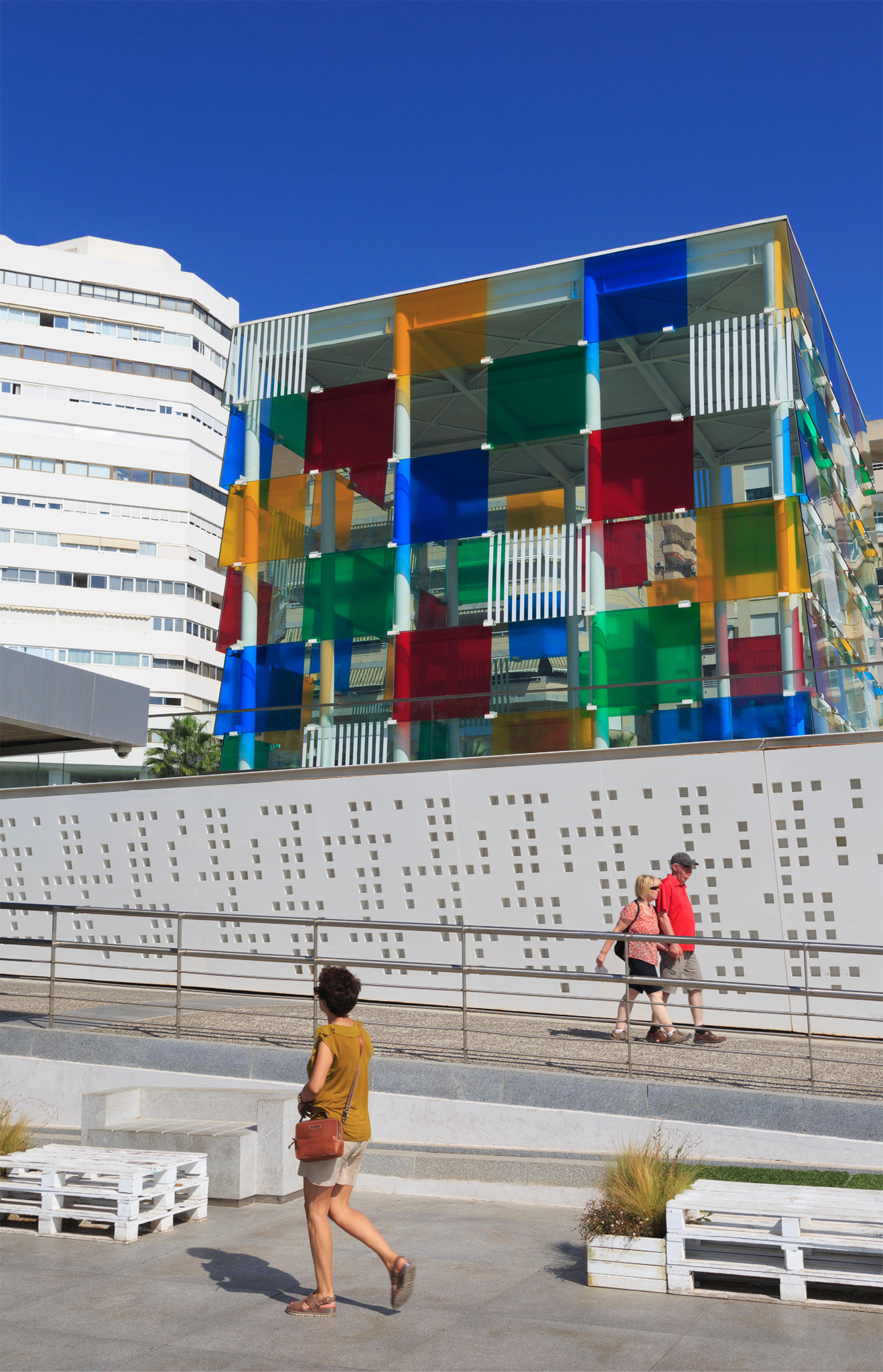
t The multicoloured, glass- cube building housing the Centre Pompidou Málaga
EXPERIENCE Andalucía
|
Eat El Tintero II A beachside seafood restaurant in Málaga with no menu – just point at the dishes you fancy when the waiters pass by with their laden trays. ⌂ Avenida Salvador Allende 340 (El Palo), Málaga § 952 20 68 26 ¡¡¡ Mesón Astorga This classical Malagueeño eatery serves dishes prepared from fresh market produce. Try the fried aubergine with sugar-cane honey. ⌂ Calle Gerona 11, Málaga ∑ mesonastorga.com ¡¡¡ |
EXPERIENCE Andalucía
|
Shop Barro de Palma Stocking Palma del Río’s best ceramics, metalwork and screen prints, this is a must-shop. You can also make your own souvenir at one of Barro de Palma’s popular ceramic workshops. ⌂ Poligono Industrial Mataché II 67–68, Palma del Río ∑ barrodepalma.com Alfajar This light and airy space is the perfect backdrop for Alfajar’s characterful ceramics. You can even take a workshop with one of Alfajar’s artisans to try your hand at throwing a pot for yourself. ⌂ Calle Císter 1, Málaga ∑ alfajar.es |
The Romans sited a strategic settlement here, on the road between Córdoba and Itálica, almost 2,000 years ago. The remains of the 12th-century city walls are a reminder of the town’s frontier days under the Almohads.
The Iglesia de la Asunción, a Baroque church, dates from the 18th century. The Monasterio de San Francisco is now a hotel, and guests can eat dinner in the 15th-century refectory here.
Palma del Río is the home town of El Cordobés, one of Spain’s most famous matadors. His biography, Or I’ll Dress You in Mourning, paints a vivid picture of life in the town and of the hardship which followed the end of the Civil War.
One of the most dramatic silhouettes in Southern Spain is that of the Castillo de Almodóvar del Río. The Moorish castle – parts of it dating from the 8th century – stands on a hilltop overlooking the whitewashed town and fields of cotton.
"
Castillo de Almodóvar del Río
§ 957 63 40 55 # 11am–2:30pm & 4–7pm Mon–Fri, 11am–7pm Sat & Sun

t Mosaic floor in the Planetarium House at the Roman ruins of Itálica
Itálica was founded in 206 BC by Scipio Africanus and it grew to become important in the 2nd and 3rd centuries AD. Emperor Hadrian, who was born in the city and reigned from AD 117–138, added marble temples and other grand buildings.
Next to the vast but crumbling amphitheatre is a display of finds from the site. Traces of Itálica’s streets and the mosaic floors of villas can be seen, but little remains of the city’s temples or its baths, as most of the stone and marble has been plundered over the centuries.
Osuna was once a key Roman garrison town. It rose again to prominence in the 16th century under the Dukes of Osuna, who wielded immense power. In the 1530s they founded the Colegiata de Santa María, a grand church with a Baroque reredos and paintings by José de Ribera. This was followed in 1548 by the university, a rather severe building with a beautiful patio. Some fine mansions, among them the Palacio del Marqués de la Gomera, also reflect the town’s former glory.
To the east lies Estepa, whose modern-day fame rests on its biscuits – polvorones and mantecados. The Iglesia del Carmen has a black and white, Baroque façade.
The Sierra Morena, clad in oak and pine woods, runs across the north of the provinces of Seville and Córdoba. It forms a natural frontier between Andalucía and the plains of neighbouring Extremadura and La Mancha. In 2014, the Sierra was declared a UNESCO Starlight Reserve and the Milky Way spans the night sky.
Fuente Obejuna, north of Córdoba, was immortalized by Lope de Vega in his play about an uprising in 1476 against a local overlord. The Iglesia de San Juan Bautista in Hinojosa del Duque is a vast church in both Gothic and Renaissance styles. Belalcázar is dominated by the tower of a ruined 15th-century castle. Storks nest on the church towers of the plateau of Valle de los Pedroches, to the east.
Cazalla de la Sierra, north of Seville, is popular with young Sevillanos at weekends. Liquor de Guindas, a concoction of cherry liqueur and aniseed, is made here.
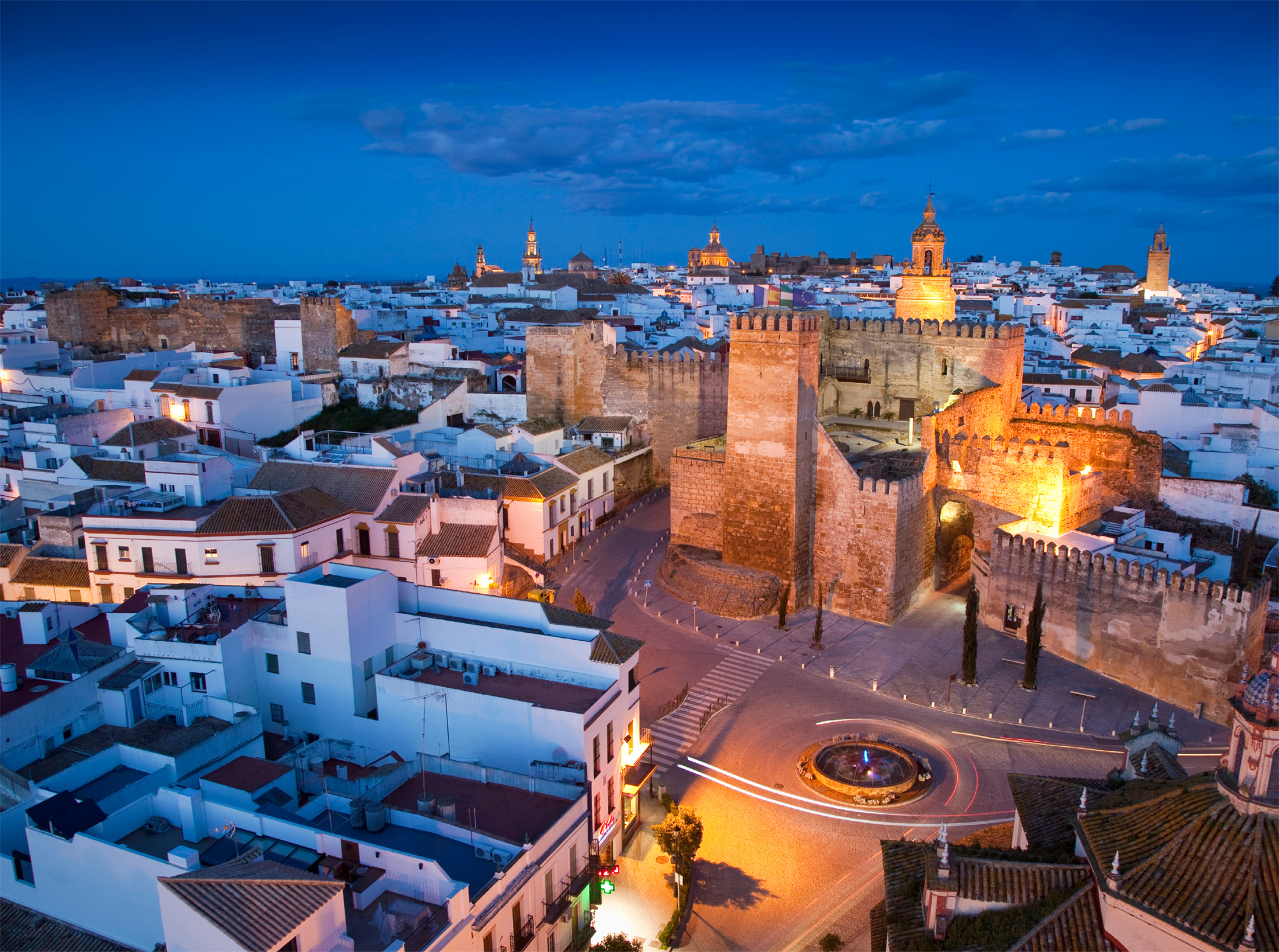
t Alcázar del Rey Pedro, a major landmark at the heart of Carmona
The first major town east of Seville, Carmona’s old quarter is built on a hill above the suburbs on the plain. Beyond the Puerta de Sevilla, a gateway in the Moorish city walls, is a dense cluster of mansions, and Mudéjar churches.
The Plaza de San Fernando has a feeling of grandeur which is characterized by the Renaissance façade of the old ayuntamiento. The present town hall, set just off the square, dates from the 18th century; in its courtyard are some Roman mosaics. Close by is the Iglesia de Santa María la Mayor. Built in the 15th century over a mosque, whose patio still survives, this is the finest of Carmona’s churches.
Dominating the town are the ruins of the Alcázar del Rey Pedro, once a palace of Pedro I, known as Pedro the Cruel. Parts of it now form a parador.
Just outside Carmona is the Necrópolis Romana, the extensive remains of a Roman burial ground. A site museum displays some of the items found in the graves, including statues, glass and jewellery.
Ayuntamiento
⌂ Calle Salvador 2 § 954 14 00 11 # 9am–2pm Mon–Fri ¢ Public hols
Necrópolis Romana
⌂ Avenida Jorge Bonsor 9 § 600 14 36 32 # 9am–6pm Tue–Sat, 9am–3pm Sun ¢ 1 Jan, 1 May & 25 Dec
Did You Know?
Geoffrey Chaucer laments Pedro the Cruel’s death in The Monk’s Tale.
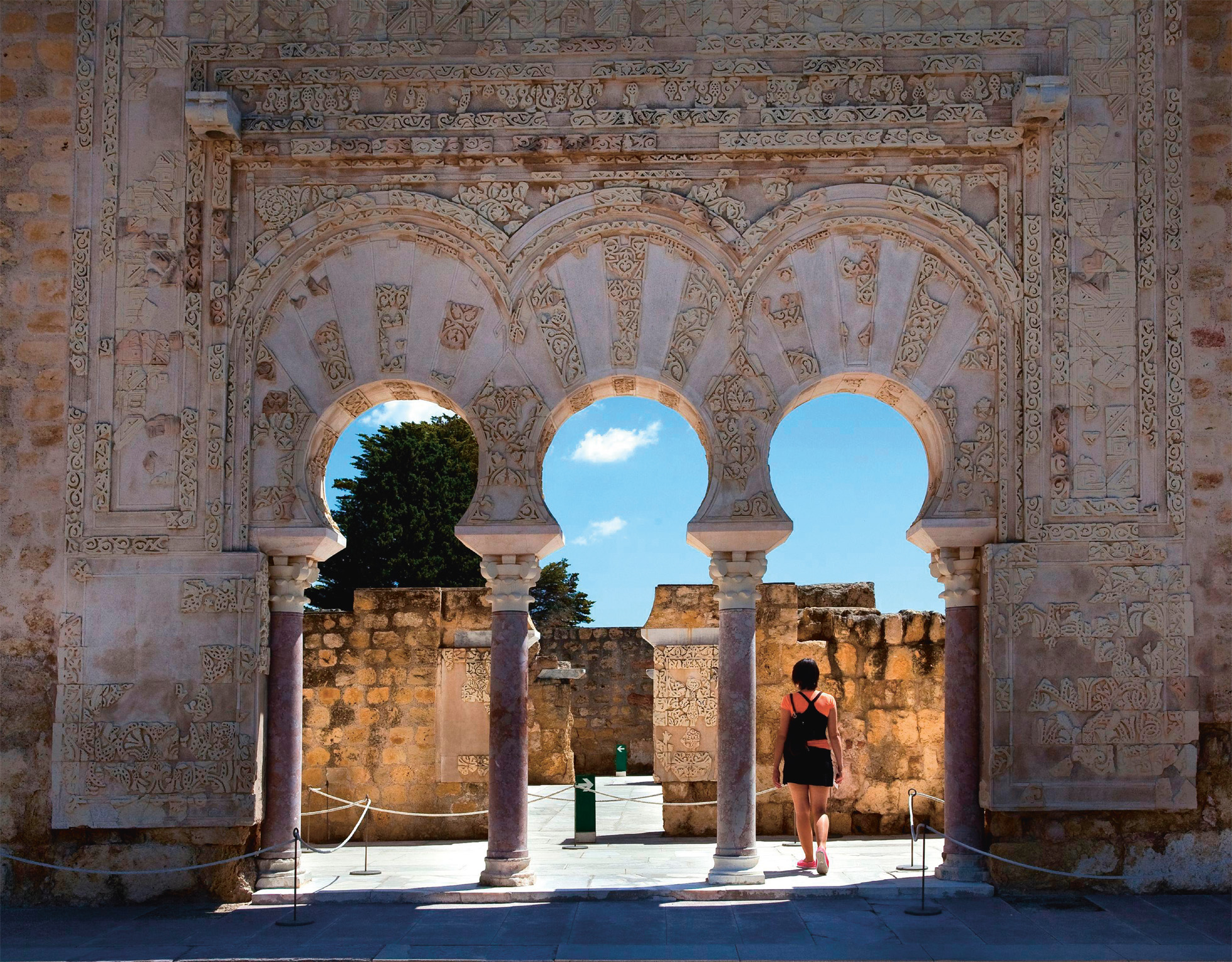
t The columns and arches of the House of Y’far at the Medina Azahara
Just a few kilometres north of Córdoba lies this once glorious palace. Built in the 10th century for Caliph Abd al Rahman III, it is named after his favourite wife, Azahara. He spared no expense, employing more than 15,000 mules, 4,000 camels and 10,000 workers to bring building materials from as far as North Africa.
The palace is built on three levels and includes a mosque, the caliph’s residence and fine gardens. Marble, ebony, jasper and alabaster once adorned the Medina Azahara’s many halls, and it is believed that shimmering pools of quicksilver added lustre.
The glory was short-lived. The palace was sacked by Berber invaders in 1010 and over subsequent centuries it was ransacked for its building materials. Now, the ruins give only glimpses of its former beauty – a Moorish main hall, for instance, decorated with marble carvings and a carved wood ceiling. The palace is currently being restored.
Écija is nicknamed “the frying pan of Andalucía” owing to its famously torrid climate. In the searing heat, the palm trees on the Plaza de España provide blissful shade and this is the ideal place to sit and observe daily life passing by, as well as for evening strolls.
Écija has 11 Baroque church steeples, many adorned with gleaming azulejos. The most florid of these is the Iglesia de Santa María, which overlooks the Plaza de España, with the Iglesia de San Juan coming a close second.
Of the many mansions along Calle Emilio Castelar, the Baroque Palacio de Peñaflor is well worth a visit. Its pink marble doorway is topped by twisted columns and it has a wrought-iron balcony.
Palacio de Peñaflor
⌂ Calle Emilio Castelar 26 § 954 83 02 73 # 10am–1:30pm & 4:30–6:30pm Mon, Tue–Fri by appt, 10am–2pm & 5:30–8pm Sat, 11am–2pm Sun

t The ornate Baroque steeple of the Iglesia de San Juan, Écija

Picture Perfect
Pretty Plaza
The Plaza de España in Écija is one of Spain’s grandest squares. Its tiled expanse is lined with Baroque palaces and Gothic churches, many of them recently renovated and in sparkling condition. To get the perfect shot, take a picture of these buildings framing the slightly austere 19th-century town hall.

t Fuente del Rey, a beautiful sight at the end of Calle del Río in Priego de Córdoba
Priego de Cordóba’s claim to be the capital of Cordoban Baroque is borne out by the dazzling work of carvers, ironworkers and gilders in the many houses, and especially churches, built with wealth generated by a prosperous 18th-century silk industry.
A restored Moorish fortress stands in the whitewashed medieval quarter, the Barrio de la Villa. Close by is the outstanding Iglesia de la Asunción, converted from Gothic to Baroque style by Jerónimo Sánchez de Rueda. Its pièce de résistance is the sacristy, created in 1784 by local artist Francisco Javier Pedrajas. The main altar is Plateresque.
At midnight every Saturday the brotherhood of another Baroque church, the Iglesia de la Aurora, parades the streets loudly singing songs in praise of the Virgin.
Silk merchants built many of the mansions that follow the curve around the Calle del Río. At the street’s end is the Baroque Fuente del Rey (King’s Fountain). The spouts splash water into three basins adorned with a riot of statuary.
Zuheros, which is perched on a crag in the limestone hills northwest of Priego, is one of Andalucía’s prettiest villages.
Montilla is the centre of an important wine region that produces an excellent smooth white fino. Unlike sherry, it is not fortified. Several bodegas, including Alvear, the oldest bodega in Andalucía, and Pérez Barquero will show visitors around by prior arrangement.
The Mudéjar Convento de Santa Clara dates from 1512. The town library is in the Casa del Inca, so named because Garcilaso de la Vega, who wrote about the Incas, lived there in the 1500s.
Overlooking the town is the medieval castle, which houses the tourist office.
'
Bodega Alvear
⌂ Avda Boucau 6 # Mon–Fri by appt ∑ alvear.es
" '
Bodega Pérez Barquero
⌂ Avenida de Andalucía 27 # Daily by appt ¢ Aug ∑ perezbarquero.com
EXPERIENCE Andalucía
|
Drink Bar Goya Carmona’s oldest bar is set in a 15th-century building but with a thoroughly modern pale blue and crimson paint job. ⌂ Calle Prim 2, Carmona ∑ goyatapas.com Copa Vino A Swedish-owned bar in Nerja, with a long list of wines available by the glass and some colourful oil paintings on display. ⌂ Calle de Almirante Ferrándiz 60, Nerja § 633 95 57 50 Bodegas Lagar Blanco The owner of this small Montilla bodega takes visitors on a tour of the vineyard before pouring out glasses of sherry for tasting. ⌂ Carretera de Cuesta Blanca, km 4, Montilla § 628 31 99 77 |
EXPERIENCE Andalucía
|
Stay Parador de Carmona This fortress in Carmona is decorated with tapestries and antiques. ⌂ Calle Alcazar, Carmona ∑ parador.es ¡¡¡ Hotel Carabeo A lovely Nerja hotel, with a leafy pool area, furnished with antiques and artworks. ⌂ Calle Hernando de Carabeo 34, Nerja ∑ hotelcarabeo.com ¡¡¡ Hotel Catedral Almería’s 19th-century manor house has large rooms, featuring coffered ceilings. ⌂ Plaza de la Catedral 8, Almería ∑ hotelcatedral.net ¡¡¡ |
Scores of clear, snow-fed springs bubble from the slopes of the Sierra Nevada; their abundance at Lanjarón, on the southern side of this great range of mountains, has given the town a long history as a health spa. From June to October, visitors flock to take the waters for arthritic, dietary and nervous ailments. But bottled water from Lanjarón is sold all over the country throughout the year.
The town’s major festival begins on the night of 23 June and ends in an uproarious water battle in the early hours of 24 June, the Día de San Juan. Everyone in the streets gets doused.
The town is on the threshold of Las Alpujarras, a scenic upland area of dramatic landscapes, where steep, terraced hillsides and deep-cut valleys conceal remote, whitewashed villages. Roads to and from Lanjarón wind slowly and dizzily around the slopes.
Built on a cliff above sandy coves, the town of Nerja lies at the foot of the Sierra de Almijara. East of the town are the Cuevas de Nerja, a series of caverns discovered in 1959. Wall paintings found here are believed to be about 20,000 years old. Only a few of the many cathedral-sized chambers are open to the public. One of them has been converted into a vast auditorium.
" '
Cuevas de Nerja
⌂ Carretera de las Cuevas de Nerja # Jul & Aug: 9:30am–6pm daily; Sep–Jun: 9:30am–3:30pm daily ¢ 1 Jan, 15 May ∑ cuevadenerja.es
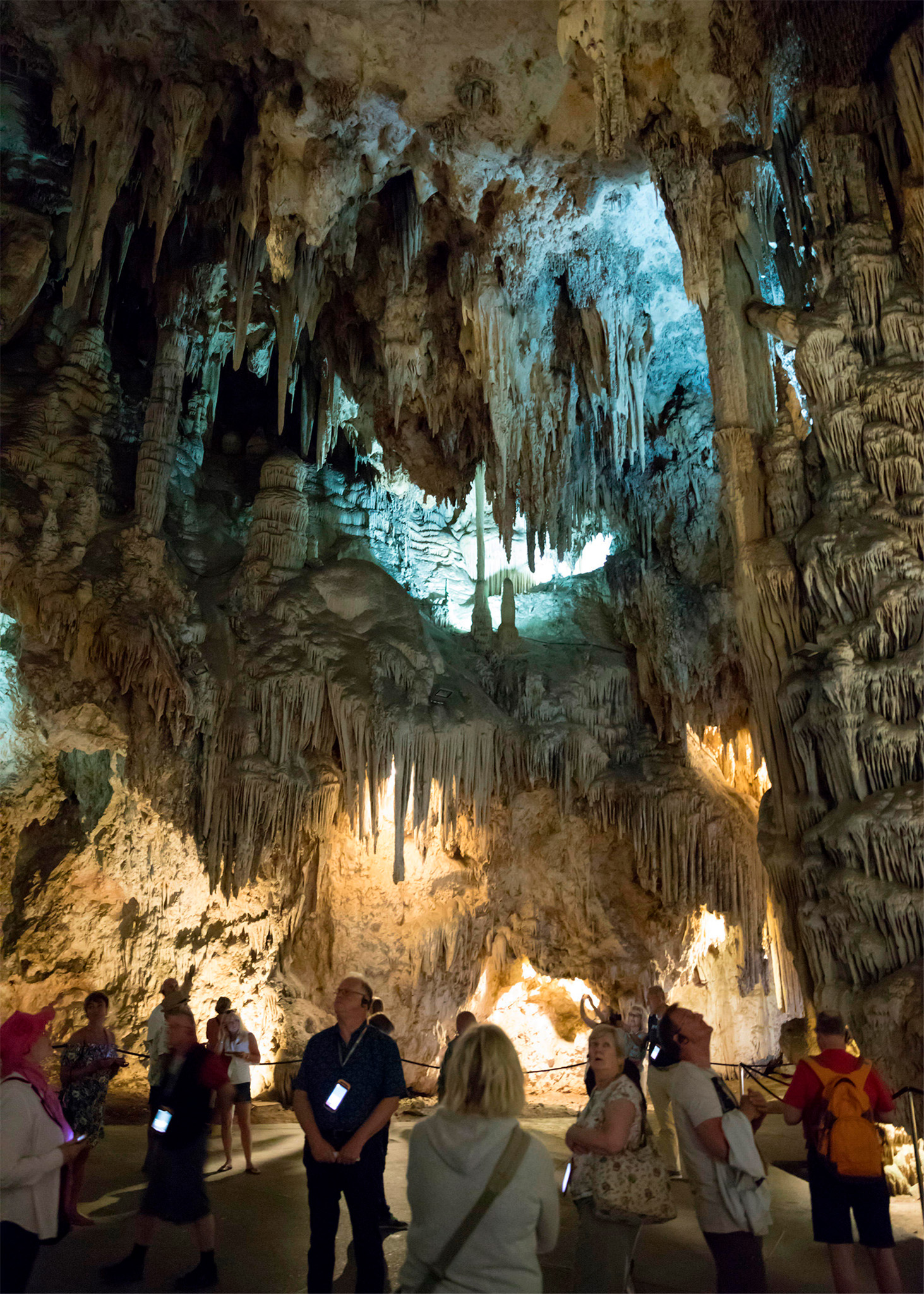
t Visitors admiring the stalactites in a cavern at the Cuevas de Nerja

Great View
Europe’s Balcony
The Balcón de Europa is a rounded esplanade atop a promontory at the heart of Nerja. Jutting out into the sea, it has views up and down the coast.
Almuñécar lies on the Costa Tropical, so named because its climate allows the cultivation of exotic fruit. The Phoenicians founded the first settlement on this fertile land, called Sexi, and the Romans constructed an aqueduct, the remains of which can be seen today. Almuñécar is now a popular holiday resort.
Above the Old Town is the castle, built by the Moors and altered in the 1500s. Below it is the Parque Ornitológico, which has an aviary and botanic gardens. The Museo Arqueológico Cueva de Siete Palacios displays a variety of Phoenician artifacts.
The ancient white town of Salobreña, 31 km (19 miles) southeast of Almuñécar, is set amid fields of sugar cane. Narrow streets lead up a hill to the Castillo de Salobreña, which has wonderful views of the Sierra Nevada.
Parque Ornitológico
⌂ Plaza de Abderraman # 10:30am–2pm & 5–8pm daily ∑ parquelorosexi.almunecar.es
"
Museo Arqueológico Cueva de Siete Palacios
⌂ Calle Cueva de Siete Palacios s/n § 958 83 86 23 # 10am–1:30pm & 5–7:30pm Tue–Sat, 10am–1pm Sun
" '
Castillo de Salobreña
⌂ Calle Andrés Segovia § 958 61 03 14 # 10am–1:30pm & 5:30–8pm daily ¢ 1 Jan, 24, 25 & 31 Dec
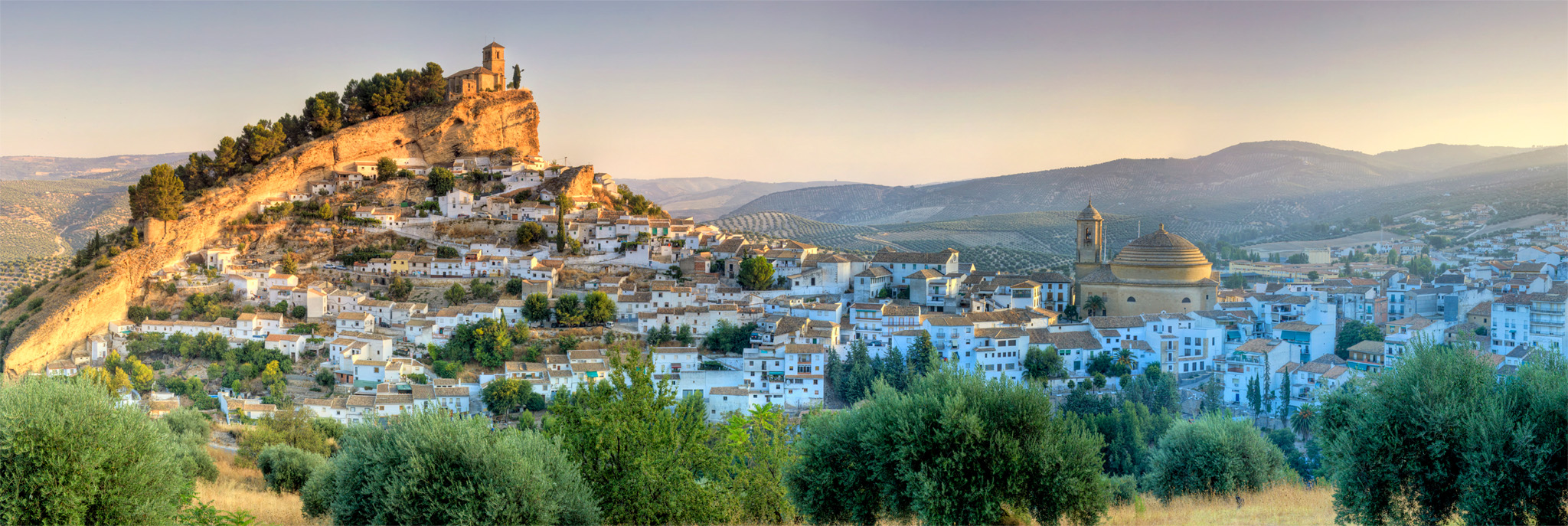
t Moorish fortifications overlooking whitewashed houses at Montefrío
The approach to Montefrío from the south offers wonderful views of tiled rooftops and pretty whitewashed houses. This archetypal Andalucían town is topped by the remains of its Moorish fortifications and the 16th-century Gothic Iglesia de la Villa. In the centre of town is the Neo-Classical Iglesia de la Encarnación, designed by Ventura Rodríguez (1717–85). The town is known for its chorizo, as well as its numerous stone crosses, thought to have been constructed in the 16th and 17th centuries.
Santa Fé, 44 km (27 miles) southeast of Montefrío, was built by the Catholic Monarchs at the end of the 15th century. Their army camped here while laying siege to Granada, and this was the site of the formal surrender of the Moors in 1492.
About 40 km (25 miles) south of Montefrío, Loja is known as “the city of water” because of its natural springs.
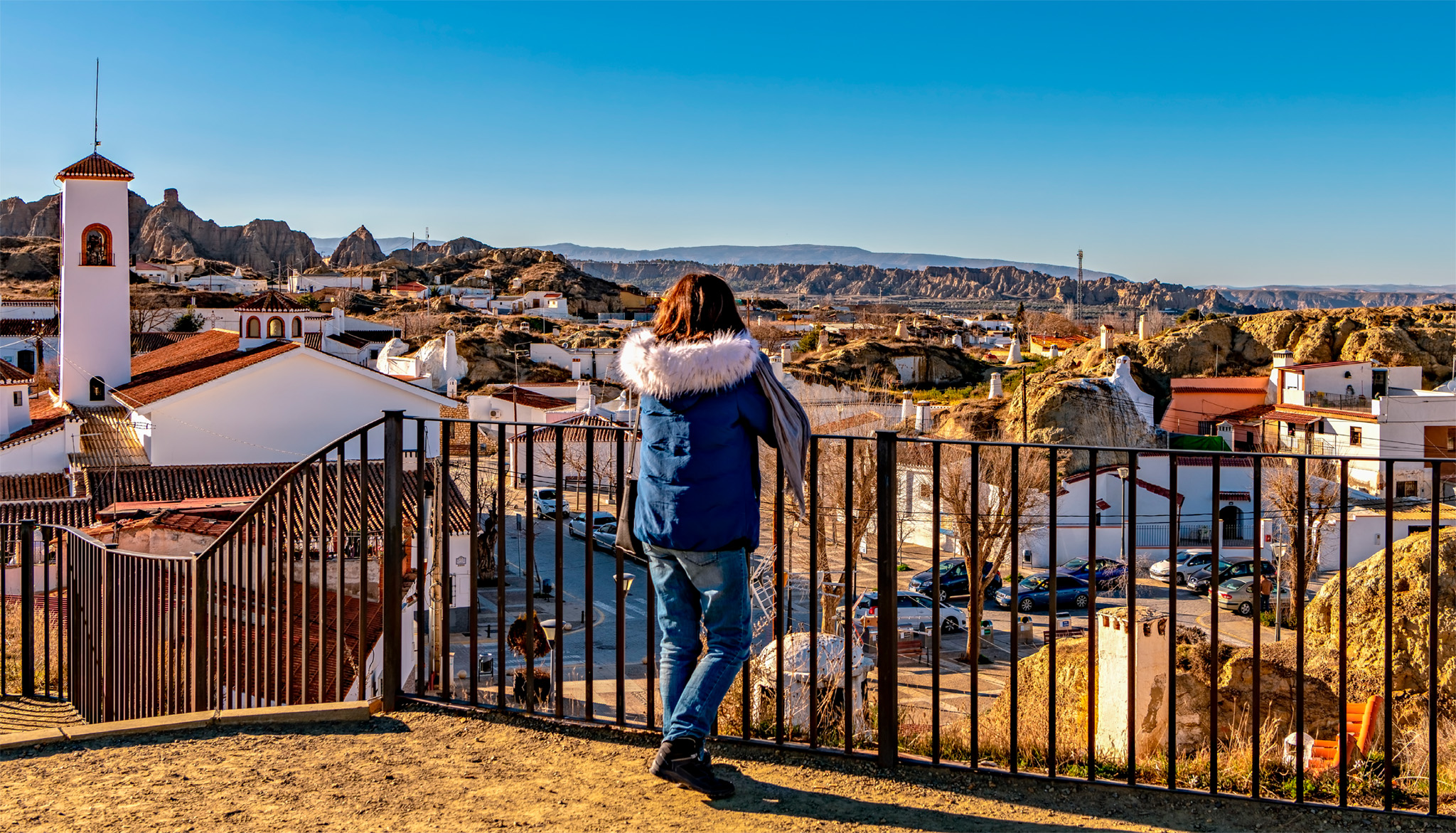
t Looking down on the cave dwellings in the troglodyte quarter of Guadix
The troglodyte quarter, with its 2,000 caves, is Guadix’s most remarkable sight. White air vents are one of the only indications of the dwellings below. The Centro de Interpretación Cuevas de Guadix and Cueva Museo de Alfarería la Alcazaba explore how people live underground.
"
Centro de Interpretación Cuevas de Guadix
⌂ Plaza de Ermita Nueva s/n § 958 66 55 69 # 10am–2pm & 4–6pm Mon–Fri, 10am–2pm Sat & public hols
"
Cueva Museo de Alfarería la Alcazaba
⌂ Calle San Miguel 57 § 958 66 47 67 # 10:30am–2pm & 4:30–8pm daily

Hidden Gem
Lady of Baza
Impressive evidence of ancient cultures based around the town of Baza, 45 km (28 miles) northeast of Guadix, came to light when a large, seated, female figure was found in a necropolis. She is the Dama de Baza, estimated to be 2,400 years old.
Situated in the arid foothills of the Sierra Nevada, Laujar looks southwards across the Andarax Valley towards the Sierra de Gádor.
Inside Laujar’s 17th-century church, La Encarnación, is a statue of the Virgin by Alonso Cano. Next to the Baroque ayuntamiento is a fountain inscribed with some lines written by Francisco Villespesa, a dramatist and poet who was born in Laujar in 1877: “Six fountains has my pueblo/He who drinks their waters/will never forget them/so heavenly is their taste.” As well as the waters, you can try the area’s hearty red wines.
Ohanes, above the Andarax valley further to the east, is an attractive hill town of steep streets and whitewashed houses known for its crops of table grapes.
Did You Know?
Legend has it that Laujar was founded by one of Noah’s grandsons.
Grim, immensely thick walls and stout, cylindrical corner towers protect this castle, which Rodrigo de Mendoza, son of Cardinal Mendoza, had built for his bride between 1509 and 1512. Inside is an ornate, arcaded Renaissance courtyard with pillars and a Carrara marble staircase.
The Moors called Jaén Geen – meaning “way station of caravans” – because of its strategic site on the road between Andalucía and Castile. Their hilltop fortress was rebuilt as the Castillo de Santa Catalina after it was captured by King Fernando III in 1246. It is now a parador.
Andrés de Vandelvira, who was responsible for many of Úbeda’s fine buildings, designed Jaén’s cathedral in the 16th century. Later additions include two 17th-century towers that now flank the west front.
An old mansion, the Palacio Villardompardo, houses a museum of arts and crafts, and also gives access to the Baños Árabes, the 11th-century baths of Ali, a Moorish chieftain. These have horseshoe arches, ceilings with star-shaped windows and two ceramic vats in which bathers once immersed themselves. Tucked away in an alley is the Capilla de San Andrés, a Mudéjar chapel founded in the 16th century by Gutiérrez González who, as treasurer to Pope Leo X, was endowed with privileges. A gilded iron screen by Maestro Bartolomé de Jaén is the highlight of the chapel.
The Real Monasterio de Santa Clara was founded in the 13th century and has a lovely cloister dating from the late 16th century. Its church, which has a coffered ceiling, contains a bamboo image of Christ made in Ecuador.
The Museo Provincial displays Roman mosaics and sculptures, and Iberian, Greek and Roman ceramics.
Castillo de Santa Catalina
⌂ Camino del Castillo § 953 12 07 33 # Jul–Sep: 10am–2pm & 5–9pm Mon–Sat, 10am–2pm Sun; Oct–Jun: 10am–6pm Mon–Sat, 10am–3pm Sun ¢ 1 Jan, 24, 25 & 31 Dec
Palacio Villardompardo
⌂ Plaza Santa Luisa de Marillac § 953 24 80 68 # 9am–10pm Tue–Sat, 9am–3pm Sun ¢ Public hols
Museo Provincial
⌂ Paseo de la Estación 29 § 953 10 13 66 # 9am–9pm Tue–Sat, 9am–3pm Sun ¢ 1 Jan, 1 May, 25 Dec

t Skiers taking to the slopes at a resort in the Sierra Nevada
Fourteen peaks more than 3,000 m (9,800 ft) high crown the Sierra Nevada mountain range. The snow lingers on these slopes until July and begins falling again in late autumn, making it a great place to hit the slopes. One of Europe’s highest roads, the A395, runs past Solynieve, an expanding ski resort, whose name means “sun and snow”, at 2,100 m (6,890 ft), and skirts the two highest peaks, Pico Veleta at 3,398 m (11,149 ft) and Mulhacén at 3,482 m (11,420 ft).
Both the Sierra’s proximity to the Mediterranean and its altitude account for the great diversity of the indigenous flora and fauna found on its slopes. Look out for soaring golden eagles and some rare butterflies fluttering around.
EXPERIENCE Andalucía
|
Eat Meson Leandro Set in a lovely city bordering the Parque Natural de Cazorla, this eatery is renowned for its carne a la piedra (stone-baked meat). ⌂ Calle Hoz 3, Cazorla ∑ mesonleandro.com ¡¡¡ Taberna Don Sancho A friendly and lively taberna serving up imaginative versions of traditional dishes. Ask for the delicious cod with blueberries – it’s divine. ⌂ Avenida de Andalucía 17, Jaén § 953 26 40 21 ¡¡¡ Restaurante Valentin This popular marisquería (restaurant specializing in shellfish) has been given a nod by the Michelin Guide. Everything is market-fresh. ⌂ Calle Tenor Iribarne 19, Almería ∑ restaurantevalentin.es ¡¡¡ |
This 2,150-sq-km (830-sq-mile) natural park’s full name is the Parque Natural de Cazorla, Segura y Las Villas. First-time visitors will be amazed by its abundant wildlife and spectacular scenery of thickly wooded mountains rising to peaks of 2,000 m (6,500 ft).
Access to the park is via whitewashed Cazorla. Among this charming city’s many draws is its imposing Moorish Castillo de la Yedra, which now houses a folklore museum, and its annual blues festival, which takes place over a few days in July.
From Cazorla, the road winds upwards beneath the ruins of the clifftop castle at La Iruela. After crossing a pass, it then drops down to a crossroads (El Empalme del Valle) in the valley of the Río Guadalquivir. Roads here lead to the river’s source and to the quiet modern parador.
If you enjoyed Cazorla’s offering, there is also a well-restored Moorish castle at Segura de la Sierra, 30 km (19 miles) from the reserve’s northern edge.
"
Castillo de la Yedra
⌂ Camino del Castillo, Cazorla § 953 10 14 02 # Mid-Jun–mid-Sep: 9am–3pm Tue–Sun; mid-Sep–mid-Jun: 9am–8:30pm Tue–Sat, 9am–3pm Sun ¢ 1 Jan, 17 Sep, 24, 25 & 31 Dec
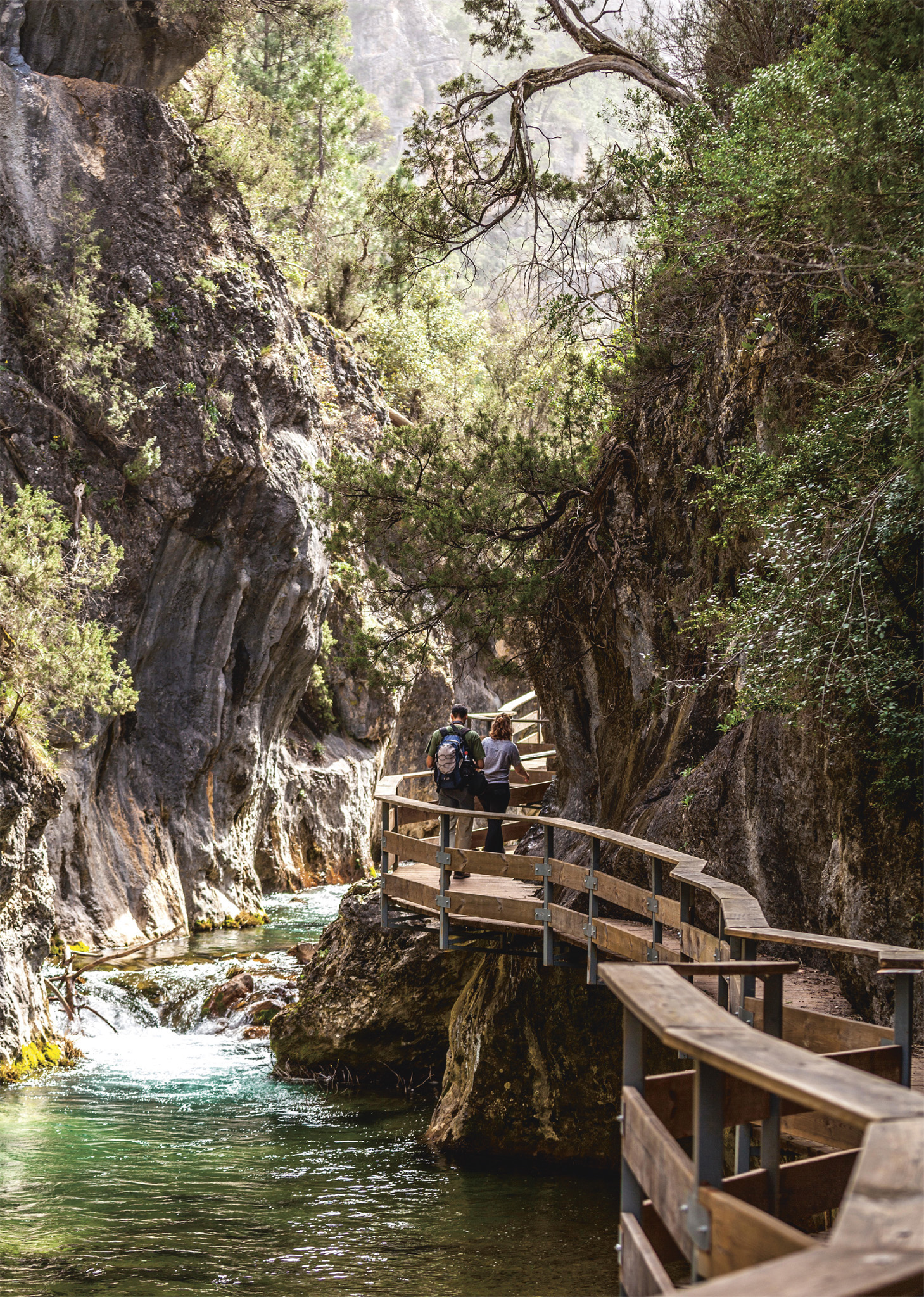
t Walking trail through wonderful scenery in the Parque Natural de Cazorla
Cazorla Wildlife
More than 100 bird species live in this nature reserve, some very rare, such as the golden eagle and the griffon vulture. Cazorla is the only habitat in Spain, apart from the Pyrenees, where the lammergeier lives. Mammals in the park include the otter – active at dawn and dusk – mouflon and wild boar, and a small remaining population of Spanish ibex. The red deer was reintroduced in 1952. Among the flora supported by the limestone geology is the indigenous Viola cazorlensis.
From a distance, Mojácar shimmers like the mirage of a Moorish citadel, its white houses cascading over a lofty ridge, 2 km (1 mile) inland from long, sandy beaches.
The village is actually made up of two distinct areas: Mojácar Pueblo (town) and Mojácar Playa (beach). Following the Civil War, Mojácar fell into ruin as most of its inhabitants emigrated, but in the 1960s it was discovered by tourists, giving rise to a new era of prosperity. The old gateway still remains, but otherwise the village has been completely rebuilt, and holiday complexes have grown up along the nearby beaches.
The coast south from Mojácar is among the least built up in Spain, with only small resorts and villages along its length.

Insider Tip
Catch the Nightbus
Admire the mountains and bird life of the Parque Natural de Cazorla from the comfort of an open-topped bus. The night tour is particularly evocative. Book online (www.cazorlatravel.es).
Just outside Linares, the ancient city of Cástulo features relics from as far back as 3000 BC, or the Neolithic period. However, most of its remains – a necropolis, an underground water storage system and residential quarters, including a synagogue – date from the Iberian and Roman civilizations.
After exploring the remains, take in the Monographic Archaeological Museum of Cástulo, which explores the history of the site through a series of exhibits.
The mighty Castillo de Vélez Blanco was built between 1506 and 1513 by the first Marquis de Los Vélez. The Renaissance interiors are now displayed in the Metropolitan Museum in New York, but there is a reconstruction of one of the patios.
Just outside, the Cueva de los Letreros contains paintings from around 4000 BC. One depicts the Indalo, a figure holding a rainbow, which has been adopted as the symbol of Almería.
" '
Cueva de los Letreros
⌂ Camino de la Cueva de los Letreros § 694 46 71 36 # By guided tour only at 4:30pm Wed, Sat & public hols, noon Sun (Jun–Aug at 7pm only); book ahead
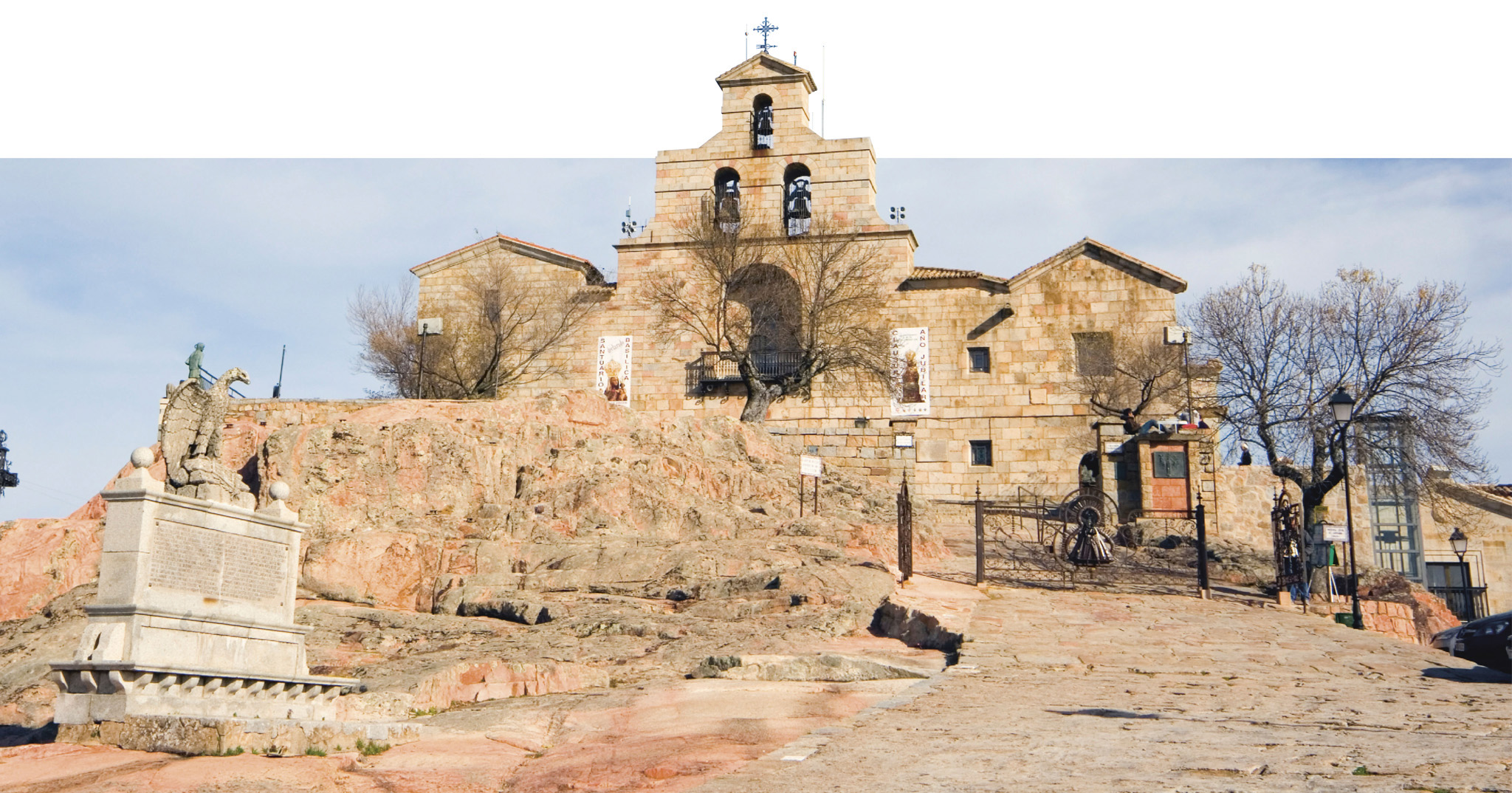
t Santuario de la Virgen de la Cabeza, near AndÚjar
Andújar stands on the site of an Iberian town, Iliturgi, which was destroyed in the Punic Wars by Scipio. The Romans built the 15-arch bridge spanning the Río Guadalquivir.
In the central square is the Gothic Iglesia de San Miguel, with paintings by Alonso Cano. The Iglesia de Santa María la Mayor has a Mudéjar tower. Inside it is El Greco’s Christ in the Garden of Olives (c 1605). In April, people make the 23-km (14-mile) pilgrimage from here to the Santuario de la Virgen de la Cabeza.
Some 29 km (18 miles) northeast of Andújar is the town of Baños de la Encina. On a hill, its fortress stands out thanks to its 15 towers, built in AD 967. Scattered below is a sea of white, red-roofed houses, dominated by a stone church. Further north, the road and railway between Madrid and Andalucía squeeze through a spectacular gorge in the eastern reaches of the Sierra Morena, the Desfiladero de Despeñaperros.
Almería’s colossal Alcazaba, dating from AD 995, is the largest fortress built by the Moors in Spain. The huge structure bears witness to the city’s Golden Age, when it was an important port under the Caliphate of Córdoba, exporting brocade, silk and cotton.
During the Reconquest, the Alcazaba withstood two major sieges before falling to the armies of the Catholic Monarchs in 1489. The royal coat of arms can be seen on the Torre del Homenaje, built during their reign.
Adjacent to the Alcazaba is the old fishermen’s and Romani quarter of La Chanca, where some families live in caves with painted façades.
Berber pirates from North Africa often raided Almería. Consequently, the cathedral looks almost like a castle, with its four towers, thick walls and small windows. The site was originally a mosque. This was converted into a church, but in 1522 it was destroyed in an earthquake. Work on the present building began in 1524 under the direction of Diego de Siloé, who designed the nave and high altar in Gothic style. The Renaissance façade and the carved walnut choir stalls are by Juan de Orea. Traces of Moorish Almería’s most important mosque can be seen elsewhere in the Templo San Juan.
The Plaza Vieja is an attractive 17th-century arcaded square. On one side is the ayuntamiento, with a cream and pink façade (1899). In Calle Real, the Castillo de Tabernas Museo del Aceite de Oliva illustrates the fine art of making olive oil.
One of Europe’s most important examples of a Copper Age settlement is located at Los Millares, near Gádor, 17 km (11 miles) north of Almería. As many as 2,000 people may have occupied the site around 2500 BC.
"
Alcazaba
⌂ Calle Almanzor # Hours vary, check website ¢ 1 Jan, 25 Dec ∑ museosdeandalucia.es
"
Castillo de Tabernas Museo del Aceite de Oliva
⌂ Calle Real 15 § 950 27 28 88 # Hours vary, call to check
Los Millares
⌂ Santa Fé de Mondújar § 677 90 34 04 # By guided tour only 10am–2pm Wed–Sun ¢ 1 & 6 Jan, 1 May, 24, 25 & 31 Dec
Spaghetti Westerns
Two towns modelled on America’s Wild West lie off the N340 highway west of Tabernas. The poblados del oeste, as they are known, were built during the 1960s and early 1970s, when low costs and eternal sunshine made Almería the ideal location for spaghetti westerns. Sergio Leone, director of The Good, the Bad and the Ugly, built a ranch here and film sets sprang up in the desert. These areas are still used for TV commercials and series, and by film directors such as Steven Spielberg.
EXPERIENCE Andalucía
|
Shop La Jarapa This is the place to buy one of Níjar’s ubiquitous rugs. La Jarapa stocks a huge range of designs made in every colour under the sun. ⌂ Avenida Federico García Lorca 62, Níjar ∑ lajarapa.com Mercado Central de Almería A great place to soak up local life, this lively food market provides the perfect introduction to Almería’s gastronomy. ⌂ Calle Circunvalación Ulpiano Díaz 14, Almería § 950 25 84 53 |

t Desert landscape around Tabernas, reminiscent of the Wild West
Tabernas is set in Europe’s only desert. The town’s Moorish fortress dominates the harsh surrounding scenery of cactus-dotted, rugged hills and dried-out riverbeds, which has provided the setting for many classic spaghetti westerns. Two film sets are now popular theme parks where you can become a cowboy for the day: Oasys – Parque Temático del Desierto de Tabernas and Fort Bravo Texas Hollywood, 1 km (1 mile) and 4 km (2.5 miles) from Tabernas respectively.
Sorbas, 25 km (16 miles) east, sits on the edge of the chasm of the Río de Aguas. Its notable buildings are the 16th-century Iglesia de Santa María and a 17th-century mansion said to have been a summer retreat for the Duke of Alba.
"
Oasys – Parque Temático del Desierto de Tabernas
⌂ Carretera N340 # Hours vary, check website ∑ oasysparquetematico.com
"
Fort Bravo Texas Hollywood
⌂ Carretera N340, Tabernas # 9am–7:30pm daily ∑ fortbravo.es

t Cabo de Gata lighthouse, perched on the end of rocks rising out of the Mediterranean
Towering cliffs formed out of volcanic rock, rolling sand dunes, endless salt flats and secluded coves characterize the 290-sq-km (110-sq-mile) Parque Natural de Cabo de Gata.
Within its confines are a few fishing villages, and the small resort of San José. A lighthouse stands at the end of the cabo (cape), which can be reached by road from the village of Cabo de Gata. The park includes a stretch of seabed 2 km (1 mile) wide and the marine flora and fauna protected within it attract scuba divers and snorkellers.
The dunes and saltpans between the cape and the Playa de San Miguel are a habitat for thorny jujube trees. Many migrating birds stop here, and among the 170 or so bird species recorded are flamingos, avocets, griffon vultures and Dupont’s larks.
A few kilometres inland off the A7, set amid citrus trees on the edge of the Sierra de Alhamilla, is picturesque Níjar. This Moorish town gained its fame from the beautifully glazed pottery and the handwoven jarapas – blankets and rugs – that are made here. The barren plain between Níjar and the sea has been brought under cultivation using vast plastic greenhouses to conserve the scarce water.
Did You Know?
Cabo de Gata may have been named after the precious agate rock found in the area.
